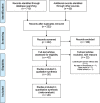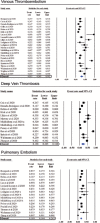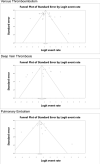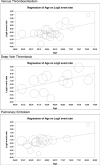COVID-19 and Venous Thromboembolism: A Meta-analysis of Literature Studies
- PMID: 32882719
- PMCID: PMC7645842
- DOI: 10.1055/s-0040-1715456
COVID-19 and Venous Thromboembolism: A Meta-analysis of Literature Studies
Abstract
Coronavirus disease 2019 (COVID-19) may have a wide spectrum of clinical presentations, leading in some cases to a critical condition with poor long-term outcomes and residual disability requiring post-acute rehabilitation. A major concern in severe COVID-19 is represented by a concomitant prothrombotic state. However, contrasting data are available about the prevalence of venous thromboembolism (VTE), including deep vein thrombosis (DVT) and/or pulmonary embolism (PE). A detailed search on the association of COVID-19 with thromboembolic complications was conducted in the main electronic databases (PubMed, Web of Science, and Scopus) according to the Preferred Reporting Items for Systematic Reviews and Meta-Analyses (PRISMA) guidelines. The weighted mean prevalence (WMP) with 95% confidence interval (95% CI) was calculated with the random-effects model. Twenty studies enrolling 1,988 COVID-19 patients were included. The WMP of VTE was 31.3% (95% CI: 24.3-39.2%). The WMP of DVT was 19.8% (95% CI: 10.5-34.0%), whereas the WMP of PE was 18.9% (95% CI: 14.4-24.3%). Similar results were obtained when specifically analyzing studies on patients admitted to intensive care units and those on patients under antithrombotic prophylaxis. Regression models showed that an increasing age was associated with a higher prevalence of VTE (Z-score: 3.11, p = 0.001), DVT (Z-score: 2.33, p = 0.002), and PE (Z-score: 3.03, p = 0.002), while an increasing body mass index was associated with an increasing prevalence of PE (Z-score = 2.01, p = 0.04). Male sex did not impact the evaluated outcomes. The rate of thromboembolic complications in COVID-19 patients is definitely high. Considering the risk of fatal and disabling complications, adequate screening procedures and antithrombotic strategies should be implemented.
Thieme. All rights reserved.
Conflict of interest statement
None.
Figures




References
-
- World Health Organization Coronavirus disease 2019 (COVID-19)Situation Report, 1. 2020. Available at:https://www.who.int/emergencies/diseases/novel-coronavirus-2019/situatio.... Accessed July 15, 2020
-
- World Health Organization Coronavirus disease 2019 (COVID-19): Situation Report, 51 2020. Available at:https://apps.who.int/iris/handle/10665/331475. Accessed July 15, 2020
Publication types
MeSH terms
Substances
LinkOut - more resources
Full Text Sources
Other Literature Sources
Medical

